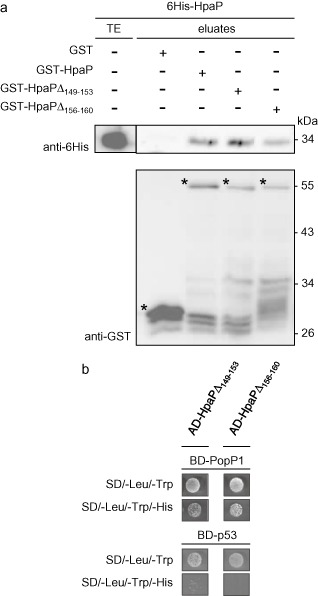Figure 7.

Interaction studies with HpaP deletion derivatives mutated in the type III secretion substrate specificity switch (T3S4) domain. (a) Deletions in the T3S4 domain do not abolish the self‐interaction of HpaP. Immobilized glutathione S‐transferase (GST), GST‐HpaP, GST‐HpaPΔ149–153 and GST‐HpaPΔ156–160 were incubated with 6His‐HpaP. Total cell lysates (TE) and eluted proteins (eluates) were analysed using antibodies directed against GST and the 6His epitope. Bands corresponding to GST and GST fusion proteins are marked by asterisks; lower bands represent degradation products. (b) Deletions in the T3S4 domain do not abolish interaction between HpaP and the type III effector PopP1. Yeast cells were co‐transformed by BD‐PopP1 and either AD‐HpaPΔ149–153 or AD‐HpaPΔ156–160. Double transformation and interaction were tested by plating yeasts on synthetic dropout medium lacking leucine and tryptophan (SD/–Leu/–Trp) and synthetic dropout medium lacking leucine, tryptophan and histidine (SD/–Leu/–Trp/–His), respectively. 3‐Aminotriazole (3‐AT) was added to suppress autoactivation. Experiments in (a) and (b) were repeated twice with similar results. AD, activation domain; BD, binding domain; His, histidine.
